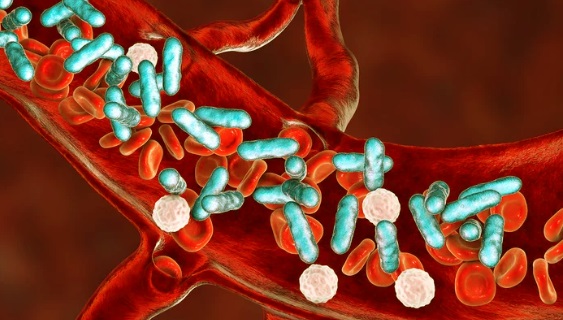Is Long COVID Nothing More Than Low-Grade Sepsis Involving Secondary Opportunistic Pathogens?
Nikhil Prasad Fact checked by:Thailand Medical News Team May 27, 2025 6 months, 4 weeks, 7 hours, 14 minutes ago
Medical News: As the world continues to grapple with the aftermath of the COVID-19 pandemic, a significant number of patients report persistent symptoms long after their initial infection has resolved. This condition, known as Long COVID or Post-Acute Sequelae of SARS-CoV-2 infection (PASC), has puzzled researchers and clinicians alike. A growing hypothesis suggests that Long COVID may share similarities with low-grade sepsis, particularly involving secondary opportunistic pathogens. This theory posits that the lingering effects of SARS-CoV-2 could be driven by a dysregulated immune response and subsequent infections, mirroring the characteristics of sepsis. Could Long COVID be a form of chronic, low-grade sepsis, or is it a distinct syndrome with unique mechanisms?
 Is Long COVID Nothing More Than Low-Grade Sepsis Involving Secondary Opportunistic Pathogens
A New Hypothesis on Long COVID
Is Long COVID Nothing More Than Low-Grade Sepsis Involving Secondary Opportunistic Pathogens
A New Hypothesis on Long COVID
This
Medical News report delves into the emerging hypothesis that Long COVID may be akin to low-grade sepsis, characterized by persistent inflammation and opportunistic infections. Sepsis is defined as a life-threatening organ dysfunction caused by a dysregulated host response to infection, often bacterial, but increasingly recognized in viral contexts like severe COVID-19. Studies have shown that severe COVID-19 can lead to viral sepsis, with up to 39.9% of hospitalized patients meeting Sepsis-3 criteria, particularly in ICU settings where the prevalence reaches 83.8%. The overlap in clinical presentation—fatigue, cognitive impairment, and multi-organ dysfunction—between Long COVID, Post-Sepsis Syndrome (PSS), and Post-Intensive-Care Syndrome (PICS) fuels speculation that Long COVID could be a prolonged septic state triggered by secondary pathogens.
The Sepsis-Long COVID Connection
The parallels between Long COVID and sepsis are striking. Both conditions involve systemic inflammation, immune dysregulation, and organ dysfunction. In severe COVID-19, SARS-CoV-2 can induce a cytokine storm, leading to multi-organ failure akin to sepsis. Autopsy studies have revealed widespread vascular damage and microthrombosis in COVID-19 patients, findings also common in bacterial sepsis. Even the endothelial layers of the gut tract are damage especially the tight-junctions are damage, compromising the gut barrier and possibly letting gut bacteria into the bloodstream.
Moreover, research indicates that secondary bacterial and fungal infections are prevalent in critically ill COVID-19 patients, with studies reporting that 20% of SARS-CoV-2-positive samples also test positive for other pathogens. These opportunistic infections, such as those caused by Staphylococcus or Pneumocystis jirovecii, may persist or recur in Long COVID patients, contributing to chronic symptoms.
The concept of low-grade sepsis in Long COVID suggests a smoldering inflammatory state. Unlike acute sepsis, which is marked by high mortality, low-grade sepsis may involve subclinical infections that perpetuate immune activation. For instance, changes in the gut microbiome following COVID-19, including increased opp
ortunistic pathogens and reduced beneficial bacteria, could sustain inflammation. This dysbiosis has been linked to persistent gastrointestinal symptoms in Long COVID, such as diarrhea and loss of appetite, which affect up to 44% of patients 90 days post-infection.
Opportunistic Pathogens and Immune Suppression
A key component of the hypothesis is the role of opportunistic pathogens. COVID-19 can suppress the immune system, particularly through T-cell exhaustion and lymphopenia, creating a window for secondary infections. Research has identified higher rates of bacterial and fungal superinfections in critically ill COVID-19 patients, with pathogens like Acinetobacter baumannii and Klebsiella pneumoniae showing significant antibiotic resistance. These infections are associated with worse outcomes and may contribute to the chronicity of Long COVID symptoms. Additionally, corticosteroid treatments, widely used in severe COVID-19, increase the risk of opportunistic infections like Pneumocystis pneumonia, further complicating recovery.
Challenges in Diagnosis and Differentiation
Distinguishing Long COVID from low-grade sepsis is challenging due to overlapping symptoms and the lack of specific diagnostic tools. Both conditions share features like fatigue, cognitive dysfunction, and muscle pain, which are also seen in PSS and PICS. A 2024 study highlighted that these syndromes cannot be reliably differentiated based on clinical presentation alone, as they may represent different labels for similar pathomechanisms. The absence of standardized biomarkers for Long COVID complicates matters further. While sepsis is often diagnosed using the Sequential Organ Failure Assessment (SOFA) score, no equivalent exists for Long COVID, leaving clinicians to rely on patient history and exclusion of other causes.
Implications for Treatment and Research
If Long COVID is indeed a form of low-grade sepsis, treatment strategies could shift toward targeting persistent inflammation and secondary infections. Antimicrobial therapies, immunomodulators, and microbiome restoration could play a role. However, the heterogeneity of Long COVID suggests that personalized approaches are needed. Ongoing research aims to identify biomarkers and therapeutic targets, with studies exploring the efficacy of antivirals, anti-inflammatory agents, and even immune checkpoint inhibitors in severe cases. The urgency of understanding Long COVID’s mechanisms is underscored by its global impact, with millions of patients experiencing reduced quality of life.
Conclusion
The hypothesis that Long COVID may be a form of low-grade sepsis involving secondary opportunistic pathogens offers a compelling framework for understanding this complex condition. While the overlap with sepsis is evident, more research is needed to confirm whether Long COVID is a distinct entity or a variant of post-sepsis syndrome. As scientists unravel the pathophysiology, the focus must remain on developing diagnostic tools and targeted therapies to alleviate the burden of Long COVID. For now, the parallels with sepsis provide a valuable lens through which to view this persistent challenge.
References
https://ccforum.biomedcentral.com/articles/10.1186/s13054-024-05076-x
https://www.frontiersin.org/journals/medicine/articles/10.3389/fmed.2023.1280951/full
https://www.thelancet.com/journals/ebiom/article/PIIS2352-3964(22)00537-0/fulltext
https://journals.lww.com/ccmjournal/fulltext/2021/12000/coronavirus_disease_2019_as_cause_of_viral_sepsis_.5.aspx
https://www.dovepress.com/understanding-post-sepsis-syndrome-how-can-clinicians-help-peer-reviewed-fulltext-article-IDR
https://onlinelibrary.wiley.com/doi/10.1002/jmv.28892
https://www.nature.com/articles/s41419-024-06642-5
https://www.cell.com/trends/parasitology/fulltext/S1471-4922(21)00175-6
https://www.thelancet.com/journals/ebiom/article/PIIS2352-3964(22)00537-0/fulltext
https://www.nationalacademies.org/based-on-science/what-is-the-connection-between-covid-19-and-sepsis
https://journals.tubitak.gov.tr/medical/vol51/iss7/18/
https://www.medrxiv.org/content/10.1101/2024.09.11.24311990v1.full
For the latest on Long COVID, keep on logging to Thailand
Medical News.
Read Also:
https://www.thailandmedical.news/news/foxp4-gene-variant-uncovered-as-key-driver-of-long-covid-globally
https://www.thailandmedical.news/news/lef1as1-gene-disruption-could-be-driving-long-covid-symptoms-in-some-patients
https://www.thailandmedical.news/news/sars-cov-2-spike-protein-found-to-be-the-main-culprit-behind-long-covid-symptoms
https://www.thailandmedical.news/articles/coronavirus
https://www.thailandmedical.news/articles/long-covid
https://www.thailandmedical.news/pages/thailand_doctors_listings
